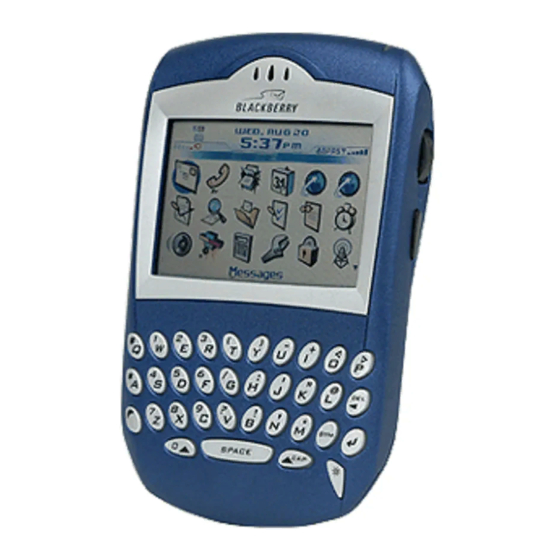- ページ 7
PDA Blackberry 7510 Wireless HandheldのPDF 安全性と製品情報をオンラインで閲覧またはダウンロードできます。Blackberry 7510 Wireless Handheld 10 ページ。 Blackberry 7510/7520 from nextel
Blackberry 7510 Wireless Handheld にも: 交換マニュアル (2 ページ), スタートマニュアル (13 ページ), ユーザーマニュアル (14 ページ)

The BlackBerry Wireless Handheld is a radio transmitter and receiver. It is designed and manufactured
not to exceed the emission limits for exposure to radio frequency (RF) energy set by the Federal
Communications Commission (FCC) of the U.S. Government and Industry Canada of the Canadian
Government (IC). These limits are part of comprehensive guidelines and establish permitted levels of
RF energy for the general population. The guidelines are based on standards that were developed by
independent scientific organizations through periodic and thorough evaluation of scientific studies.
The standards include a substantial safety margin designed to assure the safety of all persons,
regardless of age and health.
The exposure standard for wireless mobile handhelds employs a unit of measurement known as the
Specific Absorption Rate, or SAR. The SAR limit set by the FCC/IC is 1.6W/kg*. Tests for SAR are
conducted using standard operating positions specified by the FCC/IC with the handheld transmitting
at its highest certified power level in all tested frequency bands. Although the SAR is determined at the
highest certified power level, the actual SAR level of the handheld while operating can be well below
the maximum value. This is because the handheld is designed to operate at multiple power levels so as
to use only the power required to reach the network. In general, the closer you are to a wireless base
station antenna, the lower the power output.
Before a wireless handheld model is available for sale to the public, it must be tested and certified to
the FCC and IC that it does not exceed the limit established by the government-adopted requirement
for safe exposure under the recommendations of the International Commission on Non-Ionizing
Radiation Protection (ICNIRP). The tests are performed in positions and locations (for example, at the
ear and worn on the body) as required by the FCC and IC for each model.
The highest SAR values for each handheld model when tested for use at the ear is outlined below:
BlackBerry 7510 Wireless Handheld
The highest SAR values for each handheld model when worn on the body, in an approved holster or
carrying case, is outlined below:
BlackBerry 7510 Wireless Handheld
Body-worn measurements differ among wireless handheld and phone models, depending upon
available accessories and FCC and IC requirements. While there may be differences between the SAR
levels of various wireless devices and at various positions, they all meet the government requirement
for safe exposure.
The FCC has granted an Equipment Authorization for this model handheld with all reported SAR
levels evaluated as in compliance with the FCC RF emission guidelines. SAR information on this model
handheld is on file with the FCC and can be found under the Display Grant section of http://
www.fcc.gov/oet/fccid after searching on FCC ID L6ARAL10IN Additional information on Specific
Absorption Rates (SAR) can be found on the Cellular Telecommunications & Internet Association
(CTIA) web-site at http://www.wow-com.com.
___________________________________
* In the United States and Canada, the SAR limit for mobile handhelds used by the public is 1.6 watts/
kg (W/kg) averaged over one gram of tissue for the body or head (4.0 W/kg averaged over 10 grams of
tissue for the extremities - hands, wrists, ankles and feet). The standard incorporates a substantial
margin of safety to give additional protection for the public and to account for any variations in
measurements.
The long-term characteristics or the possible physiological effects of Radio Frequency Electromagnetic
fields have not been evaluated by Underwriters Laboratories Inc. (UL).
Handheld
Handheld
Safety and Product Information Booklet
1 g SAR (W/kg)
1 g SAR (W/kg)
0.91
0.78
7
